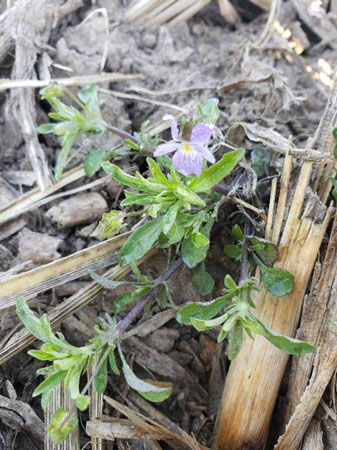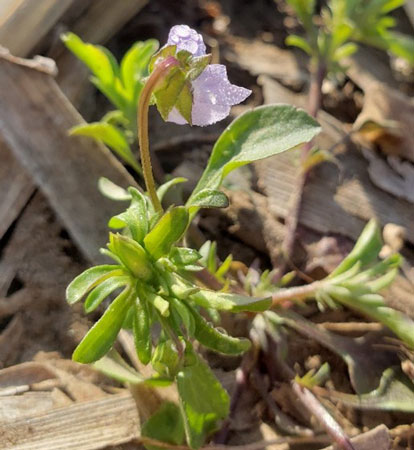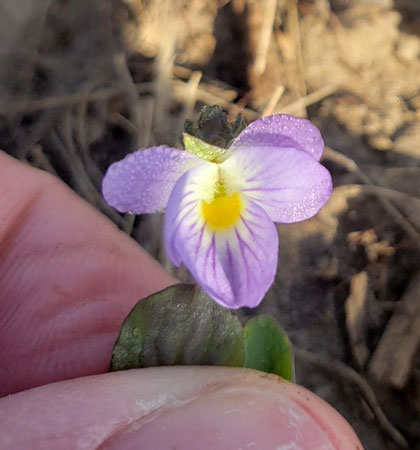The name “pansy” might prompt pictures of hardy spring bedding plants. However, this World of Weeds feature is a wild relative of those ornamentals. Field pansy (Viola bicolor), also called wild pansy or Johnny-jump-up, is more noticeable in the spring, but can be found in the fall throughout Kansas (Figure 1).

Figure 1. Field pansy growing in a crop field after harvest in the fall. Photo by Sarah Lancaster, K-State Extension.
Ecology
Field pansy is a winter annual native to North America. It can be found in fields, lawns, and roadsides throughout Kansas. It prefers sunny, well-watered sites. It can germinate in fall or spring, and grows rapidly in the spring, hence the name “Johnny-jump-up’. This weed is likely to become prevalent in fields that rely on glyphosate and 2,4-D for spring burndown applications.
Identification
Flowering stems grow upright to about 6 inches tall from a mat of basal leaves (Figure 2). Stems are angled and branch near the base. The stems of young plants are green, but they will turn purple as the plant matures (Figure 3).

Figure 2. Field pansy growing in corn stalks near Rossville, KS. Note the mat formed in the background and the upright flowering stem. Lobed stipules are seen at the base of the flowering stem on the plant in the foreground. Photo by Sarah Lancaster, K-State Extension.
Leaves are up to 2 inches long, usually smooth, and may have occasional notches in the margins. They are generally egg-shaped, becoming narrower near the flowers. Leaves are alternately arranged along the stem. Deeply lobed stipules, up to 1 inch long, occur at the base of the flowering stem.
Flowers develop on long stalks that arise from leaf axils and are protected by five light green, hairless sepals (Figure 3). When they emerge, flowers are about ½ inch across and have five petals, ranging in color from violet to cream, with the center of the flower becoming white. Petals have dark blue-violet veins. One petal has a yellow spot at the base and is surrounded by two petals that have small hairs near the base (Figure 4). Tiny, oblong, yellow-brown seeds develop in oblong capsules that are about 0.25 inch in length. The seeds are spread when they are ejected from mature capsules (a phenomenon called forced or explosive dehiscence).

Figure 3. Flowering stems become purple as they mature. Large sepals are present at the base of the flower. Photo by Sarah Lancaster, K-State Extension.

Figure 4. Field pansy flowers come in a range of colors. All flowers will have dark veins in the petals and a yellow spot near the center of the flower. Photo by Sarah Lancaster, K-State Extension.
Management
Field pansy is easier to control in the fall compared to the spring. Including a fall application of flumioxazin (Valor, others), chlorimuron (Classic), or tribenuron (Express, others) is likely to provide better control of field pansy than spring applications alone, especially late spring applications. Spring burndown applications that include dicamba will provide better control of field pansy compared to those that include 2,4-D. Products that can control field pansy in the spring include atrazine, isoxaflutole (Balance Flexx, others), mesotrione (Callisto, others), cloransulam (FirstRate, others), and thifensulfuron (Harmony, others).
For more information, see the “2025 Chemical Weed Control for Field Crops, Pastures, and Noncropland” guide available online at https://bookstore.ksre.ksu.edu/pubs/SRP1190.pdf or check with your local K-State Research and Extension office for a paper copy.
The use of trade names is for clarity to readers and does not imply endorsement of a particular product, nor does exclusion imply non-approval. Always consult the herbicide label for the most current use requirements.
Sarah Lancaster, Extension Weed Management Specialist
slancaster@ksu.edu